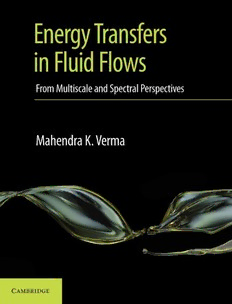
Energy Transfers in Fluid Flows: Multiscale and Spectral Perspectives PDF
Preview Energy Transfers in Fluid Flows: Multiscale and Spectral Perspectives
Energy Transfers in Fluid Flows Turbulence remains an unsolved problem due to the complex nonlinear interactions among a large number of multiscale structures. For hydrodynamic turbulence, Kolmogorov’s theory provides quantitative measures of energy contents of the fluid structures and energy flux. However, this theory based on real space description does not quantify various scale-by-scale energy transfers. In addition, generalisations of Kolmogorov’s theory to more complex system— magnetohydrodynamic and buoyancy-driven turbulence, anisotropic flows, etc.—are quite involved. Fortunately, spectral or Fourier space description, which is the theme of this monograph, overcomes some of these deficiencies. To quantify energy transfers in turbulence, Verma and his collaborators developed a set of important spectral tools: mode-to-mode energy transfers, various energy fluxes, shell-to-shell and ring-to-ring energy transfers, variable energy flux, etc. These diagnostics are quite general, and they do not require the flows to be homogeneous or isotropic, as is assumed in Kolmogorov’s theory. Researchers have used the above tools to compute important quantities for various turbulent systems. This analysis provides many valuable insights, e.g., energy transfers responsible for the magnetic energy growth in astrophysical bodies, dynamics of turbulent thermal convection. In this monograph, Verma systematically describes various techniques of energy transfers in turbulence. These tools include mode-to-mode transfers, fluxes, shell-to-shell and ring-to-ring transfers of energy, as well as enstrophy, kinetic helicity, and magnetic helicity. After developing the framework, the author employs them to turbulence in hydrodynamics, magnetohydrodynamics, passive scalar, buoyancy-driven flows, rotating flows, active scalar and vector, compressible flows, etc. The book describes energy transfers in both real and Fourier space, but the focus is on the latter. The energy transfer diagnostics provide many valuable insights, which have been described throughout the book. Mahendra K. Verma is a leading researcher in the field of turbulence. Presently he is a Professor at the Physics Department of Indian Institute of Technology Kanpur, India. He is a recipient of Swarnajayanti fellowship, INSA Teachers Award, and Dr APJ Abdul Kalam Cray HPC Award. In addition to this book, he has authored Introduction to Mechanics and Physics of Buoyant Flows: From Instabilities to Turbulence. His other research interests include nonlinear dynamics, high-performance computing, and non-equilibrium statistical physics. Energy Transfers in Fluid Flows Multiscale and Spectral Perspectives MahendraK.Verma UniversityPrintingHouse,CambridgeCB28BS,UnitedKingdom OneLibertyPlaza,20thFloor,NewYork,NY10006,USA 477WilliamstownRoad,PortMelbourne,VIC3207,Australia 314to321,3rdFloor,PlotNo.3,SplendorForum,JasolaDistrictCentre,NewDelhi110025,India 79AnsonRoad,#06–04/06,Singapore079906 CambridgeUniversityPressispartoftheUniversityofCambridge. ItfurtherstheUniversity’smissionbydisseminatingknowledgeinthepursuitof education,learningandresearchatthehighestinternationallevelsofexcellence. www.cambridge.org Informationonthistitle: www.cambridge.org/9781107176195 (cid:13)c MahendraK.Verma2019 Thispublicationisincopyright. Subjecttostatutoryexception andtotheprovisionsofrelevantcollectivelicensingagreements, noreproductionofanypartmaytakeplacewithoutthewritten permissionofCambridgeUniversityPress. Firstpublished2019 PrintedinIndia AcataloguerecordforthispublicationisavailablefromtheBritishLibrary LibraryofCongressCataloging-in-PublicationData Names: Verma,MahendraK.,1966-author. Title: Energytransfersinfluidflows: multiscaleandspectralperspectives /MahendraK.Verma. Description: Cambridge;NewYork,NY:CambridgeUniversityPress,[2019]| Includesbibliographicalreferencesandindex. Identifiers: LCCN2019016362|ISBN9781107176195(alk. paper) Subjects: LCSH:Energytransfer–Textbooks. |Fluiddynamics–Textbooks. | Multiphaseflow–Textbooks. |Turbulence–Mathematicalmodels–Textbooks. Classification: LCCQC73.8.E53V472019|DDC531/.6–dc23 LCrecordavailableathttps://lccn.loc.gov/2019016362 ISBN978-1-107-17619-5Hardback CambridgeUniversityPresshasnoresponsibilityforthepersistenceoraccuracy ofURLsforexternalorthird-partyinternetwebsitesreferredtointhispublication, anddoesnotguaranteethatanycontentonsuchwebsitesis,orwillremain, accurateorappropriate. To the seekers of knowledge, who guide the world To the workers of the world, who run the world and To the commoners of the world, who keep humanity alive Contents Preface xix Acknowledgments xxiii PartI FORMALISMOFENERGYTRANSFERS 1 Introduction 3 1.1 A Generic Nonlinear Equation 4 1.2 Outline of the Book 6 2 Basics of Hydrodynamics 9 2.1 Governing Equations of Incompressible Flows 9 2.2 Vorticity and its Equation 11 2.3 Quadratic Quantities in Hydrodynamics 12 2.4 Conservation Laws in Hydrodynamics 16 Further Reading 22 Exercises 22 3 Fourier Space Description of Hydrodynamics 23 3.1 Fourier Transform and its Properties 23 3.2 Flow Equations in Fourier Space 27 3.3 Vorticity, Kinetic Helicity, and Enstrophy 29 Further Reading 41 Exercises 41 viii Contents 4 Energy Transfers in Hydrodynamic Flows 43 4.1 Mode-to-mode Energy Transfers in Hydrodynamics 44 4.1.1 A physical argument 48 4.1.2 A mathematical argument based on tensor analysis 50 4.2 Energy Transfers in the Presence of Many Triads 52 4.3 Energy Transfers and Equations of Motion for a Two-dimensional Flow 55 4.4 Spectral Energy Flux 59 4.5 Variable Energy Flux 63 4.6 Equivalence between Various Formulas of Energy Flux 67 4.7 Shell-to-shell Energy Transfers 68 4.8 Turbulent Energy Flux and Arrow of Time 71 4.9 Spectral Decomposition, Energy Transfers, and Amplitude Equations 72 4.10 Numerical Simulations Using Spectral Method 73 4.11 Computation of Energy Transfers Using Data 75 Further Reading 77 Exercises 78 5 Energy Spectrum and Flux of 3D Hydrodynamics 79 5.1 Kolmogorov’s Theory for 3D Hydrodynamic Turbulence in Spectral Space 79 5.2 Insights from Kolmogorov’s Theory of Turbulence 83 5.3 Numerical Verification of Kolmogorov’s Theory 86 5.4 Limitations of Kolmogorov’s Theory of Turbulence 89 5.5 Energy Spectrum of Turbulent Flow in the Dissipative Regime 91 5.5.1 Pao’s model for the inertial–dissipation range of turbulence 92 5.5.2 Pope’s model for the inertial–dissipation range of turbulence 93 5.6 Energy Spectrum and Flux for Laminar Flows 95 5.7 Heisenberg’s Theory of Turbulence 98 Further Reading 100 Exercises 100 6 Enstrophy Transfers in Hydrodynamics 101 6.1 Mode-to-mode Enstrophy Transfers in Hydrodynamics 101 6.1.1 Derivation of mode-to-mode enstrophy transfer Sωω(k(cid:48)|p|q) 102 6.1.2 Derivation of mode-to-mode enstrophy transfer Sωu(k(cid:48)|p|q) 105 6.2 Mode-to-mode Enstrophy Transfers in 2D Hydrodynamics 108 6.3 Enstrophy Transfers for Many Triads 110 6.4 Enstrophy Fluxes 111
